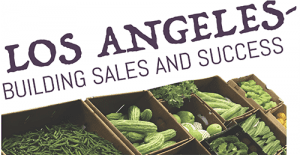Considered the nerve center for fresh produce since its opening in 1986, the Los Angeles Wholesale Produce Market is the largest wholesale market in the United States. The “new” market, as it’s known, is surrounded by produce warehouses and freeways.


It is the epicenter for the distribution of fruits and vegetables grown in California’s premier growing regions including Salinas, Oxnard, and the San Joaquin Valley, as well as shipments from Arizona, Mexico, and Washington.
With Los Angeles International Airport and the Los Angeles/Long Beach Harbor Complex to the south, the market processes produce from all over the world on a daily basis.
Francisco Clouthier, president of Maui Fresh International LLC says, “With the market’s proximity to the ports and places like Nogales, Mexico, and access to Asia and Europe, we can see what’s happening in every growing area without going anywhere. We’re close to sources throughout the world. Los Angeles is a major hub and we have a vast selection for our customers.”
The Shapiro-Gilman-Shandler Company is all about imports and stocks an extensive roster of exotics. “We’ve always offered a lot of imported items,” says Talia Shandler, director of fruit purchasing. “We bring in yali (Asian) pears and chestnuts from China, coconuts from Thailand, bananas and pineapples from Ecuador, avocados from Peru, and grapes from Chile on a regular basis.”
Cole Firman, who works in sales and marketing at specialty purveyor Coosemans LA Shipping, Inc. in nearby Vernon, counts Meyer lemons from New Zealand and blood oranges from Australia as among the importer’s bigger volume items.
“There’s a lot of talk of farm-to-table and buying local, but at the same time consumers want exotic flavors from afar — dragon fruit and rambutans from Vietnam, star fruit and mangosteens from Thailand,” Firman says. “There are certain commodities we have to import to meet consumer demand all year round, such as pomegranates, which you used to just see in season, but are now coming from Chile and India during the off season.
“Asian commodities like baby bok choy, lemongrass, and shishito peppers are now pretty mainstream,” Firman adds. “Customers call every day asking, ‘What’s new?’ In May we received our first shipment of living sea bean. It’s sort of the same category as living lettuces and herbs, but it grows in and around the ocean. We saw an opportunity, but don’t know how it will work until it’s out there. We respond to growers who want to sell new varieties and chefs who want to experiment.”
This is an excerpt from the most recent Produce Blueprints quarterly journal. Click here to read the full article.


